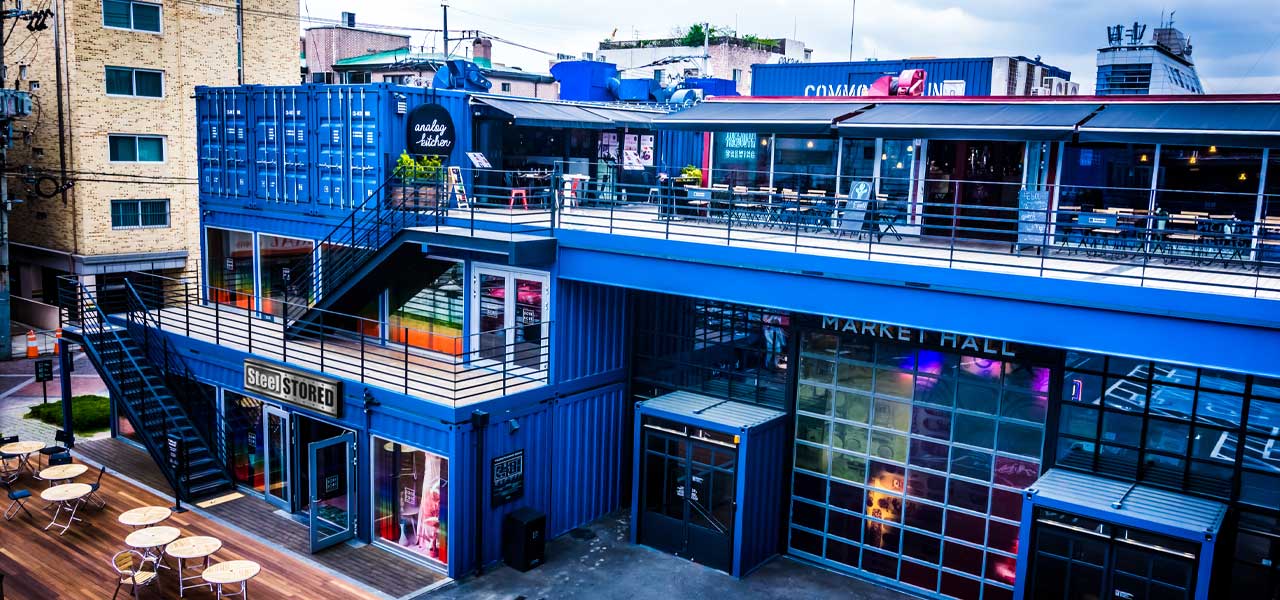
Flash Retailing Moves Into The Box: Shipping Containers
Innovation in retail has become in the box – that is, in the shipping container. What has been happening is this: Together the shipping-container industry and retailers have reimagined the standard pop-up store. They have expanded that concept from the usual short-term selling space, anchored in a shopping center, to the put-it-anywhere and then relocate-it-anywhere shipping container. The benefits outstrip what the original pop-up unleashed in retail.
Beyond Traditional Pop-Up
Timing is almost everything. This development is just in time for retailers to zero in on both the post-COVID recovery and the consumer revolution during the pandemic.
All those doing the counting project high growth for the retail sector. App For Shopify Oberlo, for example, estimates 4.1 percent for 2022. In addition, Raydiant, which provides experience platforms, reports on the shifts in customer behavior. Those include the demand for hybrid shopping. That is, they want both the brick-and-mortar and online channels. Therefore, the number of physical locations for stores is increasing. Brick-and-mortar can take the form of the portable pop-up.
Short-Term Advantage
Although the pop-up concept dates back to Vienna in 1298, it wasn’t until The Great Recession that it took off in the U.S. Like many trends, that started in the west. Being freed up from a long-term lease reduced retailing risk. And the arrangement came to be a perfect fit for seasonal sales. But that old-line version of flash retailing could lose popularity since the shipping-container innovation liberates way beyond that.
Infinite Flexibility
For one thing, except for conforming with zoning regulations, retailers have complete control over their “box.” No shopping center rules. They can customize the space in any way.
In addition, there is no need to conform to one size fits all, as when leasing temporary space in shopping centers. Shipping containers come in a range of sizes. Also available are special accommodations such as permanent toilet facilities.
The box is portable. It is equipped with hinges for easy loading to be shipped to the next location. This is in sync with the post-COVID mandate to go where the customer is. No longer can retailers expect customers to come to them.
Speed is a competitive weapon. And the business can be configured to pop up more rapidly than the conventional kind of flash retailing.
The contours can fit into rigid spaces. Therefore, no location is unthinkable.
Weather is not a deterrent. Constructed to stand up to the tests of the seas, shipping containers can function under any and all conditions in the outdoors. If the outdoor clothing brand wants to sponsor a special event in rugged terrain, that’s doable.
Retailer Wish-List
Management consulting firm McKinsey & Co. documents that COVID has changed retailing forever. That means that smart retailers have to keep reviewing their strategies and tactics. The unique capabilities of in-the-shipping container pop-up concept allows the kind of continual analysis, testing, and implementation.
Specifically, retailers can:
- Expand an e-commerce business to a form of brick-and-mortar. And, on a trial basis. During those “pilot programs” they can experience in real time what is working and not working and do on-the-spot course correction.
- Reach out to new market segments. One might be college students. Usually college campuses don’t permit permanent vendor structures. Shipping containers get around that. Also, their offbeat attributes could be attractive to youth.
- Introduce a new brandname or reinforce a current one in diverse settings, cost-effectively. The fun nature of the mobile pop-up can create lots of buzz.
- Getting back in touch with customers. Some businesses are doing that through traveling the nation in a recreational vehicle. Connecting in the space of a customized mobile shipping container can be lots more effective.
- Maintain the business in the pop-up while the permanent brick-and-mortar is being renovated. There’s no break in continuity.
The First Steps
“Michael,” retailers throughout New England ask me, “How can we get a feel for developing a portable pop-up shipping-container strategy?’
Of course there is anxiety. But there is also excitement. And visions of increased business dance through retailers’ heads.
The first step is to visit mobile pop-ups and observe. Often, they are in farmers’ markets, carnivals, concerts, trade shows, and even not far from shopping centers. It is useful to check out the layout, the traffic, interactions with customers, and any nearby competitive activity. Then there’s the decision: Is any of that a good fit for the particular retailer’s business?
If retailers envision a fit, then they owe their business the time to invest in a consultation. SteelStored provides them on a complimentary basis.
Retailers will explain their needs, geographical reach, and budget.
Then SteelStored points them in the right direction about:
Size
Price Points
Regulations
Shipping
Experts for Customization.
Magic of Non-Selling Sales
The in the box portable pop-up strategy, done right, can conjure up the magic of what’s called “non-selling sales.” The context sets in play a force field. Browsers become buyers. The late Harvard Business School Marketing Professor Ted Levitt noted this: Americans love to buy but they don’t like to be sold to. Mobile pop-ups can bypass the usual selling-to.
